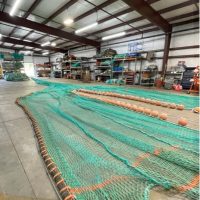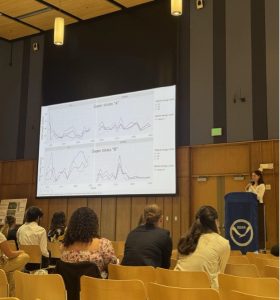Trawling through fishery data during 2025 Hollings Scholarship internship
Running for six decades is the NOAA Northeast Fisheries Science Center’s (NEFSC) bottom trawl survey, one of the longest running of its kind in the world. Operating on multiple legs, this year’s trawl was aboard the Henry B. Bigelow, monitoring fishery stock abundance and distribution on the Northwest Atlantic continental shelf from Cape Lookout, North Carolina, to the Scotian Shelf.

The data collected from the trawl when it operated in the Gulf of Maine and Massachusetts Bay is what Hannah Tucker immersed herself in this summer, as part of her NOAA Hollings Scholarship internship. Hannah is a Marine Biology major at the University of Washington, in her 4th year. “This survey is a fisheries independent survey, meaning it collects data for fisheries population management separately from commercial and recreational fisheries catch data,” Hannah said. One of Hannah’s tasks was to look at alternative designs to the NEFSC bottom trawl survey, which is highly managed and conducted in a very rigorous standardized method. “Because of this, little change has occurred to the survey design over the course of the six decades it has been running,” Hannah said.
One of the desired outcomes of looking at alternative survey designs is to increase overall efficiency. Hannah ran tests to determine the effects that each of her proposed changes would have on the level of sampling effort in the areas she altered and determined the specific differences in population abundance estimates compared to the original survey design. “I found that for the specific changes to the survey I tested, there were very minimal changes to the estimates of fish populations,” Hannah shared.
Hannah’s project focused on data collected for two species of groundfish found in the Gulf of Maine and Massachusetts Bay: winter flounder (Pseudopleuronectes americanus) and yellowtail flounder (Pleuronectes ferruginea). Fun fact: both species are right-eyed fish, with both their eyes on the right side of their bodies. “I hope to continue my research and expand my models to include other species of New England groundfish as well,” Hannah said. She will continue to meet virtually with her mentors, Emily Liljestrand and Amanda Hart, throughout the upcoming year to re-run her model applied to different species. “What this means is changing some species-specific parameters and uploading new trawl data. We hope to work towards publishing over the year, which would include expanding to different areas of the bottom trawl survey as well.”
Work such as Hannah’s is important for the future and laying the groundwork for the next steps the people in charge of the survey may take to enhance overall efficiency of the survey. “Continuing this survey is critically important for the stock assessments of multiple fish populations across the New England and Mid-Atlantic area, but it’s an expensive and time-consuming process,” Hannah said. “Improving sampling efficiency is desirable to save resources and help with the continuation of the survey every year.

Over her 10-week summer internship, Hannah was able to learn new skills and build on existing knowledge gained through her degree at UW Marine Biology. One of the top things she learned was independent research project development. “Making decisions about what I want to research and focus on, without other people telling me what would be best, was an especially important learning experience during my internship,” Hannah shared. “I was working through a lot of questions with the study design on my own, and I loved the opportunity to think through these issues and brainstorm solutions to then discuss with my mentors afterwards.”
A key part of the NOAA Hollings Scholarship is broadening horizons for students—not only in science, but through meeting and working with other scientists. “The highlight of my internship was meeting so many scientists at the NEFSC. I got to talk and connect with many people working in all different departments, from age and growth to protected species,” Hannah said. “It was super cool to learn about all of the different opportunities in NOAA and to hear all the stories of how people got to where they are today!”
